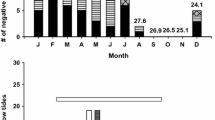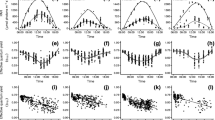Summary
We have investigated the diurnal response of photosynthesis and variable photosystem II (PSII) chlorophyll fluorescence at 77 K for thalli of the chlorophyte macroalga, Ulva rotundata, grown in outdoor culture and transplanted to an intertidal sand flat in different seasons. The physiological response in summer indicated synergistic effects of high PFD and aerial exposure, the latter probably attributable to temperature, which usually increased by 8 to 10° C during midday emersion. Except at extreme emersed temperatures in summer (38° C), the light-saturated photosynthesis rate (Pm) did not decline at midday. In contrast, light-limited quantum yield of photosynthetic O2 exchange (τ) and the ratio of variable to maximum fluorescence yield (Fv/Fm) reversibly declined during midday low tides in all seasons. Shade-grown thalli exhibited a fluorescence response suggestive of greater photodamage to PSII, whereas sun-grown thalli had greater photoprotective capacity. The fluorescence decline was smaller when high tide occurred at midday, and was delayed during morning cloudiness. These results suggest that the diurnal response to PFD in this shallow water species is modified by tidal and meteorological factors. U. rotundata has a great capacity for photoprotection which allows it to tolerate and even thrive in the harsh intertidal environment.
Similar content being viewed by others
Abbreviations
- Fo :
-
instantaneous yield of chlorophyll fluorescence
- Fm :
-
maximum yield of fluorescence
- Fv :
-
variable yield (Fm−Fo) of fluorescence
- PFD:
-
photon flux density (400–700 nm)
- Pm :
-
light-saturated rate of photosynthesis
- PSH:
-
photosystem II
- QA :
-
electron acceptor of PSII
- τ:
-
light-limited quantum yield of photosynthesis
References
Adams WW III, Díaz M, Winter K (1989) Diurnal changes in photochemical efficiency, the reduction state of Q, radiationless energy dissipation, and non-photochemical fluorescence quenching in cacti exposed to natural sunlight in northern Venezuela. Oecologia 80: 553–561
Adams WW III, Smith SD, Osmond CB (1987) Photoinhibition of the CAM succulent Opuntia basilaris growing in Death Valley: evidence from 77 K fluorescence and quantum yield. Oecologia 71: 221–228
Beer S, Eshel A (1983) Photosynthesis of Ulva sp. I. Effects of desiccation when exposed to air. J Exp Mar Biol Ecol 70: 91–97
Bilger W, Björkman O, Thayer SS (1989) Light-induced spectral absorbance changes in relation to photosynthesis and the epoxidation state of xanthophyll cycle components in cotton leaves. Plant Physiol 91: 542–551
Björkman O (1987) Low-temperature chlorophyll fluorescence in leaves and its relationship to photon yield of photosynthesis in photoinhibition. In: Kyle DJ, Osmond CB, Arntzen CJ (eds) Photoinhibition. (Topics in photosynthesis, vol. 9). Elsevier, Amsterdam, pp. 123–144
Bose S, Herbert SK, Fork DC (1988) Fluorescence characteristics of photoinhibition and recovery in a sun and a shade species of the red algal genus Porphyra. Plant Physiol 86: 946–950
Butler WL, Kitajima M (1975) Fluorescence quenching in photosystem II of chloroplasts. Biochim Biophys Acta 376: 116–125
Connell JH (1972) Community interactions on marine rocky intertidal shores. Ann Rev Ecol System 3: 169–192
Critchley C (1988) The molecular mechanism of photoinhibitionfacts and fiction. Aust J Plant Physiol 15: 195–205
Demmig B, Björkman O (1987) Comparison of the effect of excessive light on chlorophyll fluorescence (77 K) and photon yield of O2 evolution in leaves of higher plants. Planta 171: 171–184
Demmig-Adams B (1990) Carotenoids and photoprotection in plants: A role for the xanthophyll zeaxanthin. Biochim Biophys Acta 1020: 1–24
Dring MJ, Brown FA (1982) Photosynthesis of intertidal brown algae during and after periods of emersion: a renewed search for the physiological causes of zonation. Mar Ecol Prog Ser 8: 301–308
Fork DC, Bose S, Herbert SK (1986) Radiationless transitions as a protection mechanism against photoinhibition in higher plants and a red alga. Photosynth Res 10: 327–333
Franklin LA, Levavasseur G, Osmond CB, Henley WJ, Ramus J (1991) Two components of onset and recovery during photoinhibition of Ulva rotundata. Planta, in review
Gamon JA, Pearcy RW (1989) Leaf movement, stress avoidance and photosynthesis in Vitis californica. Oecologia 79: 475–481
Gamon JA, Pearcy RW (1990a) Photoinhibition in Vitis californica. The role of temperature during high-light treatment. Plant Physiol 92: 487–494
Gamon JA, Pearcy RW (1990b) Photoinhibition in Vitis californica. Interactive effects of sunlight, temperature and water status. Plant Cell Environ 13: 267–275
Gosner KL (1971) Guide to identification of marine and estuarine invertebrates. Cape Hatteras to the Bay of Fundy. Wiley-Interscience, New York London Sydney Toronto, 693 pp.
Henley WJ (1988) Physiological response of Ulva to changes in growth irradiance. Ph.D. Dissertation, Duke University, 140 pp.
Henley WJ, Levavasseur G, Franklin LA, Osmond CB, Ramus J (1991a) Photoacclimation and photoinhibition in Ulva rotundata as influenced by nitrogen availability. Planta 184: 235–243
Henley WJ, Levavasseur G, Franklin LA, Lindley ST, Osmond CB, Ramus J (1991b) Diurnal responses of photosynthesis and fluorescence in Ulva rotundata acclimated to sun and shade in outdoor culture. Mar Ecol Prog Ser 75: 19–28
Henley WJ, Ramus J (1989) Photoacclimation of Ulva rotundata under steady state conditions. Mar Biol 103: 261–266
Herbert SK (1990) Photoinhibition resistance in the red alga Porphyra perforata. The role of photoinhibition repair. Plant Physiol 92: 514–519
Herbert SK, Waaland JR (1988) Photoinhibition of photosynthesis in a sun and a shade species of the red algal genus Porphyra. Mar Biol 97: 1–7
Huppertz K, Hanelt D, Nultsch W (1990) Photoinhibition of photosynthesis in the marine brown alga Fucus serratus as studied in field experiments. Mar Ecol Prog Ser 66: 175–182
Kok B, Gassner EB, Rurainski HJ (1965) Photoinhibition of chloroplast reactions. Photochem Photobiol 4: 215–227
Krause GH (1988) Photoinhibition of photosynthesis. An evaluation of damaging and protective mechanisms. Physiol Plant 74: 566–574
Larkum AWD, Wood WF (1990) The effect of UV-B radiation on photosynthesis and photosystem II of phytoplanktonic and benthic algae and seagrasses. In: Baltscheffsky, M (ed) Current Research in Photosynthesis, vol. II. Kluwer, Dordrecht, pp. 385–388
Ludlow MM (1987) Light stress at high temperature. In: Kyle, DJ, Osmond, CB, Arntzen, CJ (eds) Photoinhibition. (Topics in photosynthesis, vol. 9). Elsevier, Amsterdam, pp. 89–109
Nultsch W, Pfau J, Huppertz K (1990) Photoinhibition of photosynthetic oxygen production and its recovery in the subtidal red alga Polyneura hilliae. Bot Acta 103: 62–67
Nultsch W, Pfau J, Materna-Weide M (1987) Fluence and wavelength dependence of photoinhibition in the brown alga Dictyota dichotoma. Mar Ecol Prog Ser 41: 93–97
Ramus J (1982) Engelmann's theory: the compelling logic. In: Srivastava LM (ed) Synthetic and Degradative Processes in Marine Macrophytes. Walter de Gruyter, Berlin New York, pp. 29–46
Saffo MB (1987) New light on seaweeds. Bioscience 37: 654–664
Schonbeck MW, Norton TA (1978) Factors controlling the upper limits of fucoid algae on the shore. J Exp Mar Biol Ecol 31: 303–313
Schonbeck MW, Norton TA (1980) The effects on intertidal fucoid algae of exposure to air under various conditions. Bot Mar 23: 141–147
Schreiber U, Berry JA (1977) Heat-induced changes of chlorophyll fluorescence in intact leaves correlated with damage of the photosynthetic apparatus. Planta 136: 233–238
Smith CM (1984a) Drying enhances tolerance to high temperature stress for an intertidal alga Porphyra perforata J Ag. Am Zool 24(3): 29A
Smith CM (1984b) Influences of seasonal changes in tidal exposure on photosynthesis, growth and reproduction by Porphyra perforata J Ag. Plant Physiol 75(s): 190
Smith CM, Berry JA (1986) Recovery of photosynthesis after exposure of intertidal algae to osmotic and temperature stresses: comparative studies of species with differing distributional limits. Oecologia 70: 6–12
Underwood AJ (1980) The effects of grazing by gastropods and physical factors on the upper limits of distribution of intertidal macroalgae. Oecologia 46: 201–213
Zaneveld JS (1969) Factors controlling the delimitation of littoral benthic marine algal zonation. Am Zool 9: 367–391
Author information
Authors and Affiliations
Rights and permissions
About this article
Cite this article
Henley, W.J., Lindley, S.T., Levavasseur, G. et al. Photosynthetic response of Ulva rotundata to light and temperature during emersion on an intertidal sand flat. Oecologia 89, 516–523 (1992). https://doi.org/10.1007/BF00317158
Received:
Accepted:
Issue Date:
DOI: https://doi.org/10.1007/BF00317158




